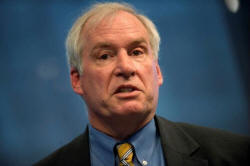|
If inflation reaches the Fed's goal while the unemployment rate,
now at a 16-year low of 4.2 percent, is below 4 percent that may
be a signal that the economy could be overheating, Rosengren
suggested in an interview.
To stabilize inflation at 2 percent, Rosengren said, "you might
have to overshoot" by pushing rates higher than the level
expected in a healthy economy. In September, Fed officials
estimated that so-called neutral rate to be 2.8 percent.
The comments mark Rosengren, who does not vote on policy this
year, as slightly more hawkish than most of his colleagues.
The Fed left rates unchanged last month, but signaled it would
likely raise them again in December, and three more times next
year.
Still, Rosengren's view lags the faster rate-hike path signaled
by many monetary policy rules, including one authored and
championed by Stanford University professor John Taylor.
Monetary policy rules specify where interest rates should be
given the level of inflation and the state of the economy, and
central bankers often use them to guide their rate-setting.
Rosengren spoke at an interview on Saturday at the close of a
two-day conference on monetary policy rules, during which Taylor
gave a formal presentation.
Taylor, among several candidates being considered by President
Donald Trump to run the U.S. central bank after Fed Chair Janet
Yellen's term ends in February, has long argued that the Fed has
kept rates too low for too long because of the risk of unwanted
inflationary pressures.
Taylor also embraces legislation, now under consideration by the
U.S. Congress, that would require the Fed to follow a monetary
policy rule like his when setting policy. That is a requirement
resisted by many Fed officials, including Yellen and Rosengren,
who said at the conference that legislating a monetary policy
rule would be "counterproductive."
Still, asked how he would feel if the next Fed chair wanted to
enshrine a rule that suggests a faster pace of rate hikes into
law, Rosengren sounded unbothered.
"My hope would be that they were flexible and pragmatic enough
that if the rule wasnít working particularly well that they
would make adjustments," he said. "For example, reading John
Taylorís paper at this conference, he seemed pretty flexible: he
talked about a variety of different rules, talked about
different ways that they could be implemented."
(Reporting by Ann Saphir; Editing by Leslie Adler)
[© 2017 Thomson Reuters. All rights
reserved.] Copyright 2017 Reuters. All rights reserved. This material may not be published,
broadcast, rewritten or redistributed.
 |
|




